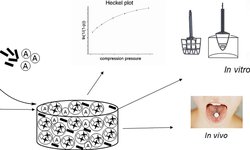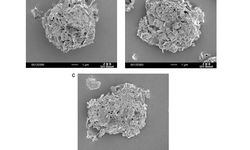Scientific papers
Due to the growing interest in multifunctional excipients for tablet formulation, the coprocessing of individual excipients is commonly employed to create excipients with enhanced multifunctionality, surpassing the individual excipients or their physical mix. The application of chitin as an excipient in tablet formulation faces limitations due to drawbacks such as poor flowability and low true density. This study aims to address these issues by coprocessing chitin with calcium carbonate (CaCO3) through the precipitation of CaCO3 on chitin particles using various methods. Additionally, optimization of the coprocessed chitin was conducted to enhance its properties. Physicochemical characterization, including CaCO3 content, true density, X-ray diffraction, infrared spectroscopy, and scanning electron microscopy, along with functional testing encompassing swelling force, flowability, tensile strength, deformation mechanism, and disintegration time, were employed to evaluate the coprocessed product. Results revealed the precipitation of calcite CaCO3 polymorph on the chitin surface, with interactions occurring at the carbonyl- and amide-group levels. Moreover, the coprocessed excipient exhibited improved true density and powder flowability, forming a single layer of CaCO3 on the surface of chitin particles. Tablet compression studies demonstrated that the coprocessed powder displayed intermediate deformation behavior between CaCO3 (most brittle) and chitin (most plastic). The tablets exhibited acceptable tensile strength and rapid disintegration (2-4 s). These findings underscore the potential utilization of coprocessed chitin-CaCO3 as a multifunctional excipient for the fast disintegration of tablets produced through direct compression.
Comments
No comments posted yet.
Add a comment















